Sayur Lodeh is an Indonesian dish made with vegetables and tofu, simmered in coconut milk that is infused with a homemade spice paste. You can customize this gravy to make it vegetarian by omitting the dried shrimp and using veggies such as chayote, eggplant, green beans, carrots, cabbage, and spinach. This sweet and savory dish is a perfect main course when served with rice cakes or steamed rice!
This recipe for Sayur Lodeh is based on my husband’s method. When we were living in Singapore for a year, my kids became more familiar with South East Asian food. My husband, who was born and raised in Singapore, finds Southeast Asian cuisine familiar and comforting. As my kids explored the various dishes, one of my family’s perennial favorites was the Sayur Lodeh. This dish achieves the trifecta of being healthy, tantalizingly savory, and yet simple. This recipe uses common spices and herbs such as coriander and chili making Sayur Lodeh incredibly healthy and a great remedy for colds.
What is Sayur Lodeh?
Sayur Lodeh describes both the ingredients and method. ‘Sayur’ means vegetable in Malay and ‘Lodeh’ is a specific cooking method where ingredients are cooked until soft. We need to distinguish between lodeh and lemak in the context of this dish, as the terms can be and are used interchangeably. Lodeh is a cooking technique where ingredients are cooked until soft.
Lemak, on the other hand, refers to the use of coconut milk as the primary medium of cooking the ingredients. When a dish is lemak, the rich nutty flavor of the coconut is amplified. You may also hear of a dish called ‘lontong’, especially in Malaysia and Singapore. Specifically, lontong is a compressed rice cake. However, since ‘lontong’ is served as an accompaniment to Sayur Lodeh, the dish can also be referred to as lontong.
Interesting facts about the ingredients:
Galangal:
Galangal is a close relative to ginger, as both belong to the Zingiberaceae family. That said, galangal has a sharper, spicier, and more peppery flavor than its sweeter cousin. It has a distinct flavor compared to the regular ginger. Galangal has been a staple ingredient in Asian (and I mean from Southeast to East to South Asian) medicinal lore. It is believed to possess anti-inflammatory and antioxidant properties, helps relieve discomfort, nausea, and motion sickness, improves blood circulation, and is a great source of iron, sodium, and vitamins A and C. If you absolutely cannot find galangal, then you can substitute it with fresh ginger.
Turmeric:
Sayur Lodeh, traditionally, can be white or yellow. Simply put, the distinction between white and yellow is based on the inclusion or exclusion of turmeric. Sayur Lodeh without turmeric can be pale white or light green depending on the vegetables that you use, while the sunny natural yellow coloring of turmeric gives this dish its iconic look.
Turmeric, like galangal, is also a major staple of Asian medicine because it possesses anti-inflammatory properties and is a strong antioxidant. That said, you can either use Javanese turmeric (Curcuma xanthorrhiza) which is native to Southeast Asia or the more common Curcuma longa, which is grown in India and other parts of Asia. Unless your preparation is super delicate (teas or tisanes) you can not taste the difference. If you cannot find fresh turmeric, feel free to use ground turmeric. Fresh turmeric must be peeled; use only the orange-yellow part of the turmeric without the skin.
Chayote:
Chayote is a gourd that is native to Central and South America. It has many nutrients, especially folate (vitamin B9) and multiple antioxidants including vitamin C and myricetin. This squash provides a great backdrop vegetable because while it can absorb the flavors of the dish, it is also low in calories, carbs, and fat. One thing to note though is that the chayote needs to be cleansed of its bitterness by slicing the tip of the vegetable and using the tip to scrub in a circular motion on the fleshy part. (See image below) Then, rinse off the bitter froth before peeling and chopping the vegetable. This light green vegetable is available in most grocery stores in the Asian vegetable aisle.
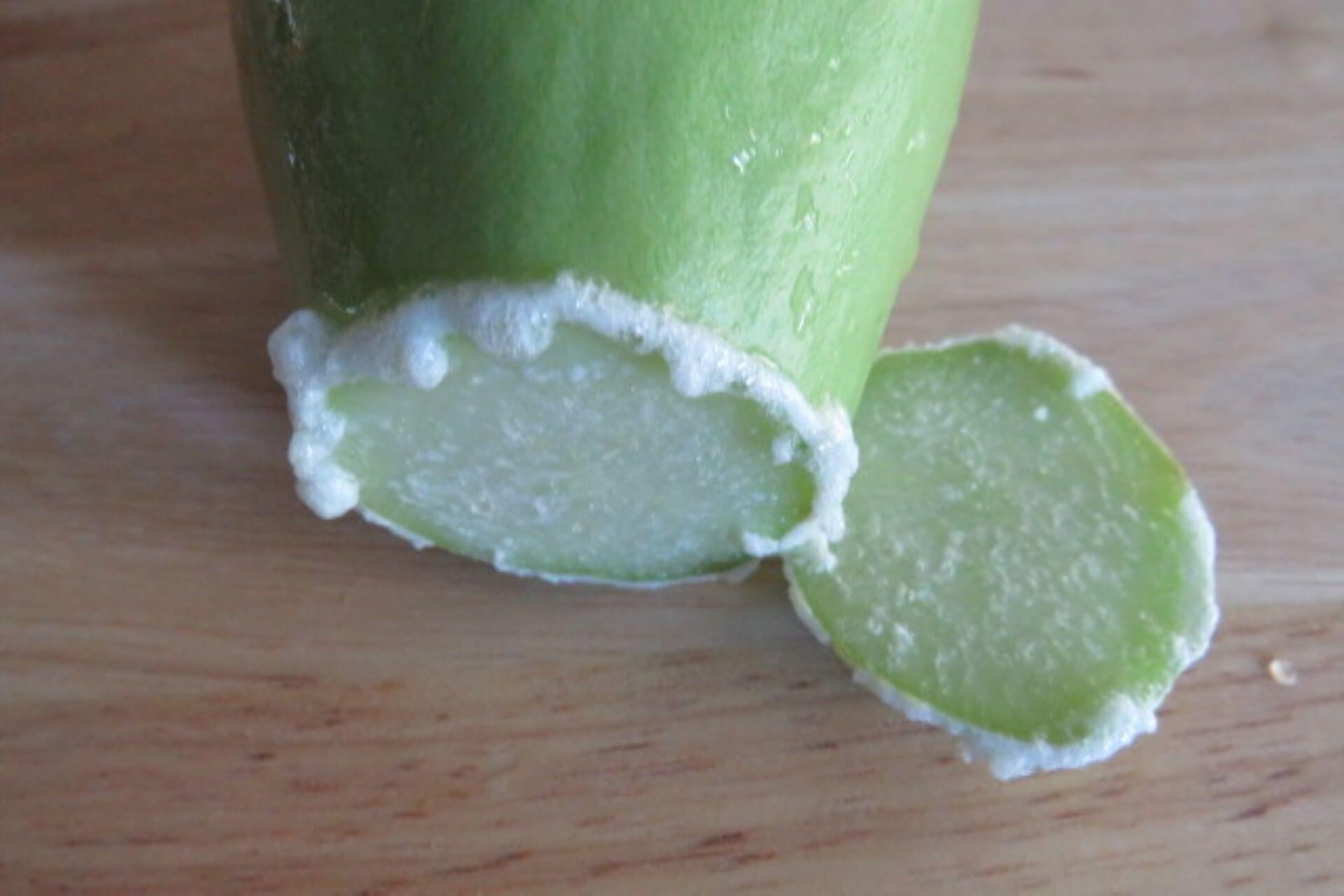
Coconut milk:
Yes, coconut milk is a high-calorie ingredient. But bear in mind, that it is also an excellent source of fiber, vitamin C, folate (vitamin B9), iron, magnesium, potassium, copper, manganese, and selenium. Many studies have also found that coconut milk reduces “bad cholesterol” (LDL) and raises the “good cholesterol” (HDL). That said, I am a strong proponent of moderation in everything, and my recipe reflects that approach.
As you can see, this dish is incredibly versatile, healthy, and hearty. You can fast cook it (if you’re in a hurry), or slow cook it. It can be served as a side dish, sometimes as a soup, or as a main course. But, it does bring a hint of tropical sunshine and heat on a cold fall or winter’s day.
Frequently Asked Questions:
- Are there other variations for the Sayur Lodeh? You could use fresh or frozen shrimp with tofu, or make it vegetarian by omitting the shrimp paste or terasi (dried shrimp) with broccoli, mushrooms, carrots, and long beans.
2. Should I use the Chinese eggplant?
For this dish, I like the Chinese eggplant because its sweetness is a great foil against all the spices in this dish. While there are over ten varieties of eggplant, I have found that the lack of bitter seeds makes the Chinese version hold the distinct flavors of Sayur Lodeh together. If you cannot find the Chinese eggplant, you can substitute it with other eggplant varieties.
3. What can I substitute for candlenuts in this recipe?
The other unique aspect of Sayur Lodeh is that it utilizes the full spectrum of the spice islands, with ingredients such as candlenuts, galangal, and lemongrass. Candlenut may be unfamiliar to some of you. If you’ve visited Hawaii, you’ll know it as the kukui nut. Candlenuts can be slightly toxic and should not be eaten raw. You need to roast or cook these nuts to neutralize the alkaloids. It has the added benefit of enhancing the flavor. If you cannot access the candlenut, you can substitute it with its close cousin, the macadamia nut as I have done in my recipe.
4. Can I make this recipe ahead of time?
Of course, Sayur Lodeh tastes better the next day as the sweet and savory flavor profiles from the coconut milk, shallot, and turmeric meld together with the heat from the chilis.
If you’ve tried this recipe or have questions, I would love to hear from you. Please feel free to share (below) your thoughts, comments, or any questions that you might have. And if you like my recipes, you could subscribe to my mailing list for the latest recipes that will be delivered to your inbox. From my pen to your table, Bon Appetit!
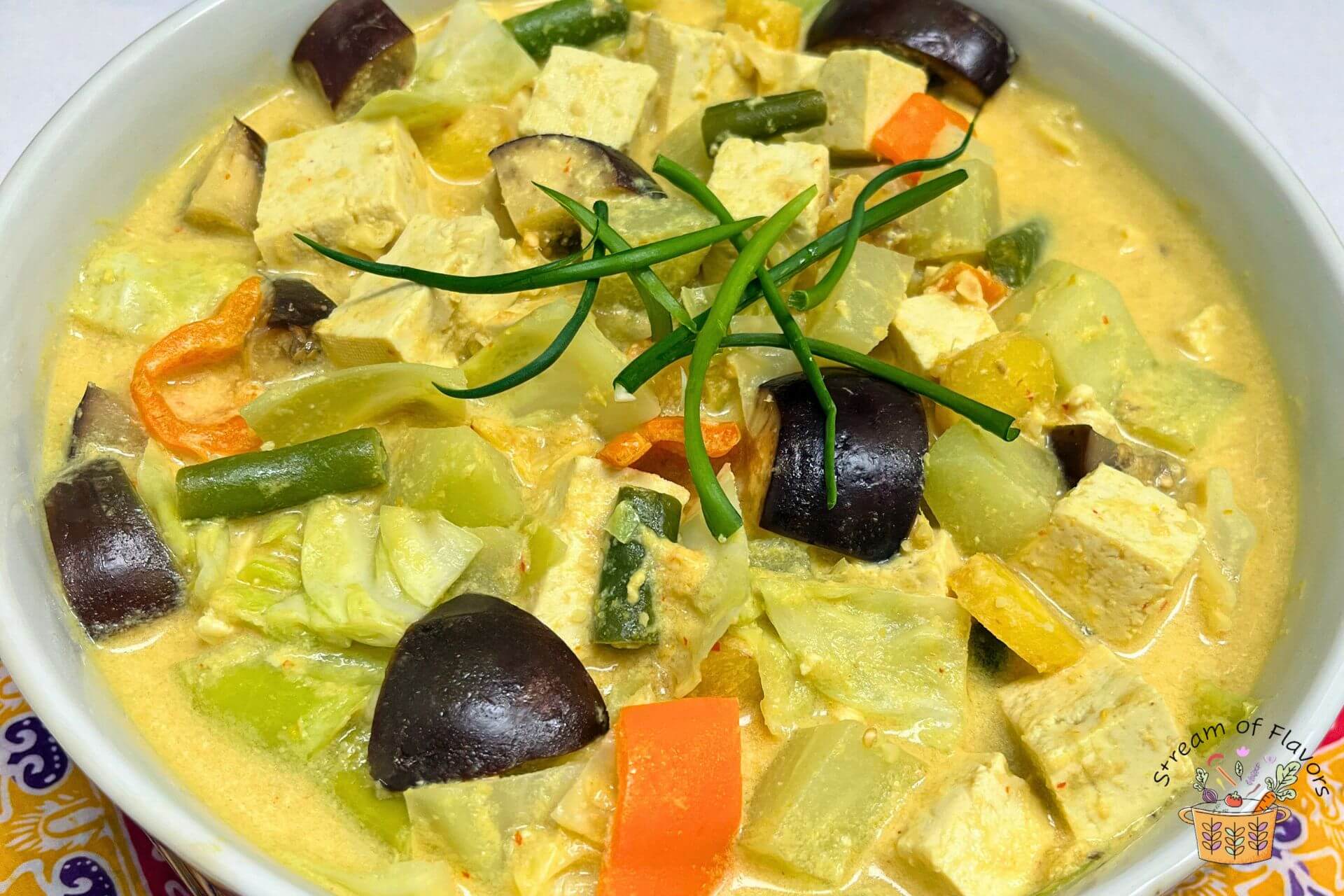
Ingredients:
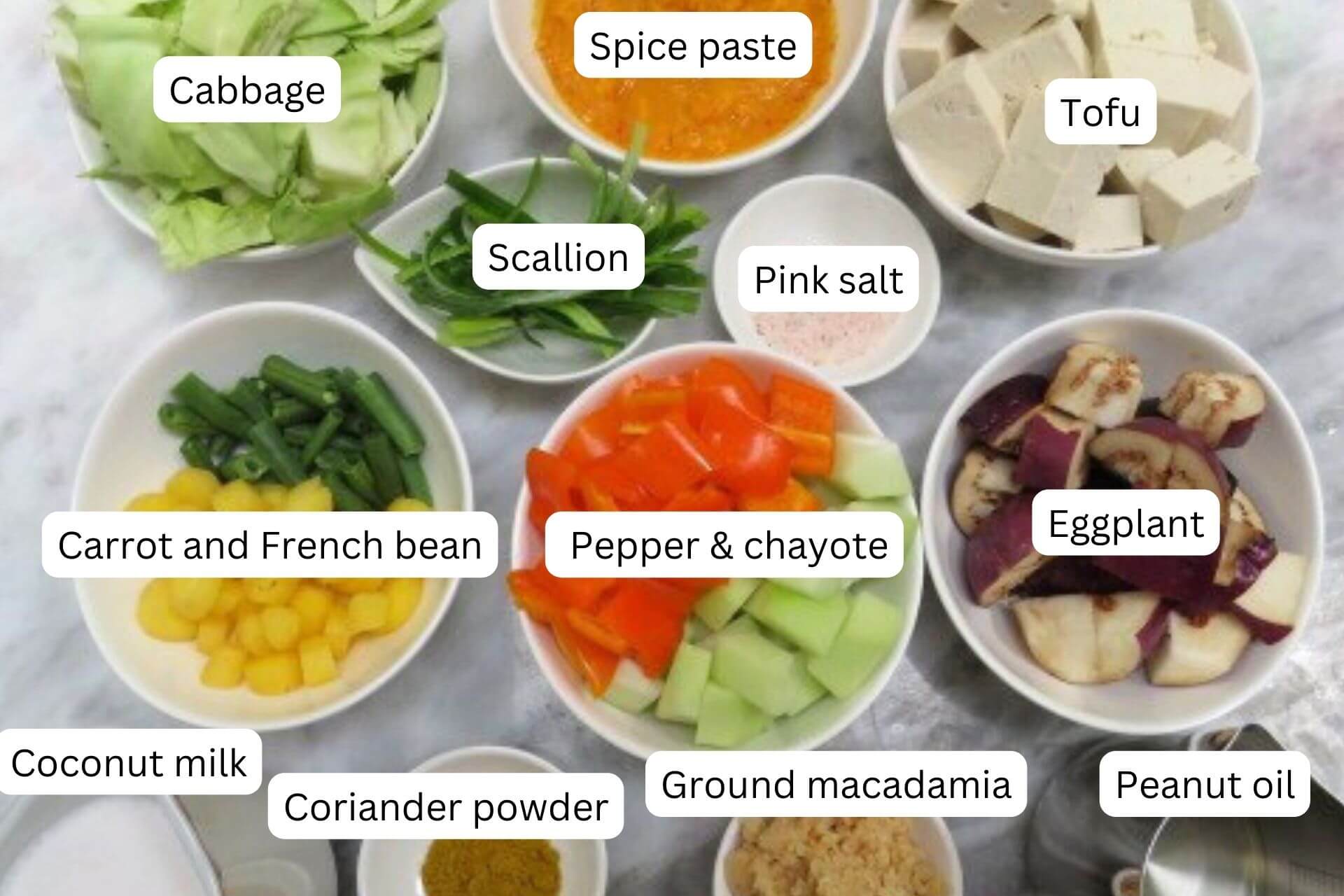
- Spice paste: fresh turmeric (substitute with turmeric powder), dried shrimp or shrimp paste, dried red chili, galangal (or use ginger), shallot, lemongrass (white part only)
- Veggies: carrots, green beans, eggplant, cabbage, pepper and scallion for garnish
- Coconut milk: fresh coconut milk or unsweetened canned coconut milk
- Spice/nuts: coriander powder and ground macadamia nuts (use candlenuts if you can find them)
- Tofu: firm tofu (silken tofu will disintegrate in the gravy, so you need to be careful when stirring the gravy)
Here are the step-by-step instructions on how to make this dish. Please refer to the recipe card below for the measurements.
How to make Sayur Lodeh:
- Soak the ingredients for the spice paste for 10 minutes and grind to a smooth paste in a spice grinder. Heat a wok with the peanut oil and sauté the spice paste for a minute or until fragrant.

2. Toss in the chayote, carrots, green beans, and a cup of water and cook for 3 minutes on medium heat.
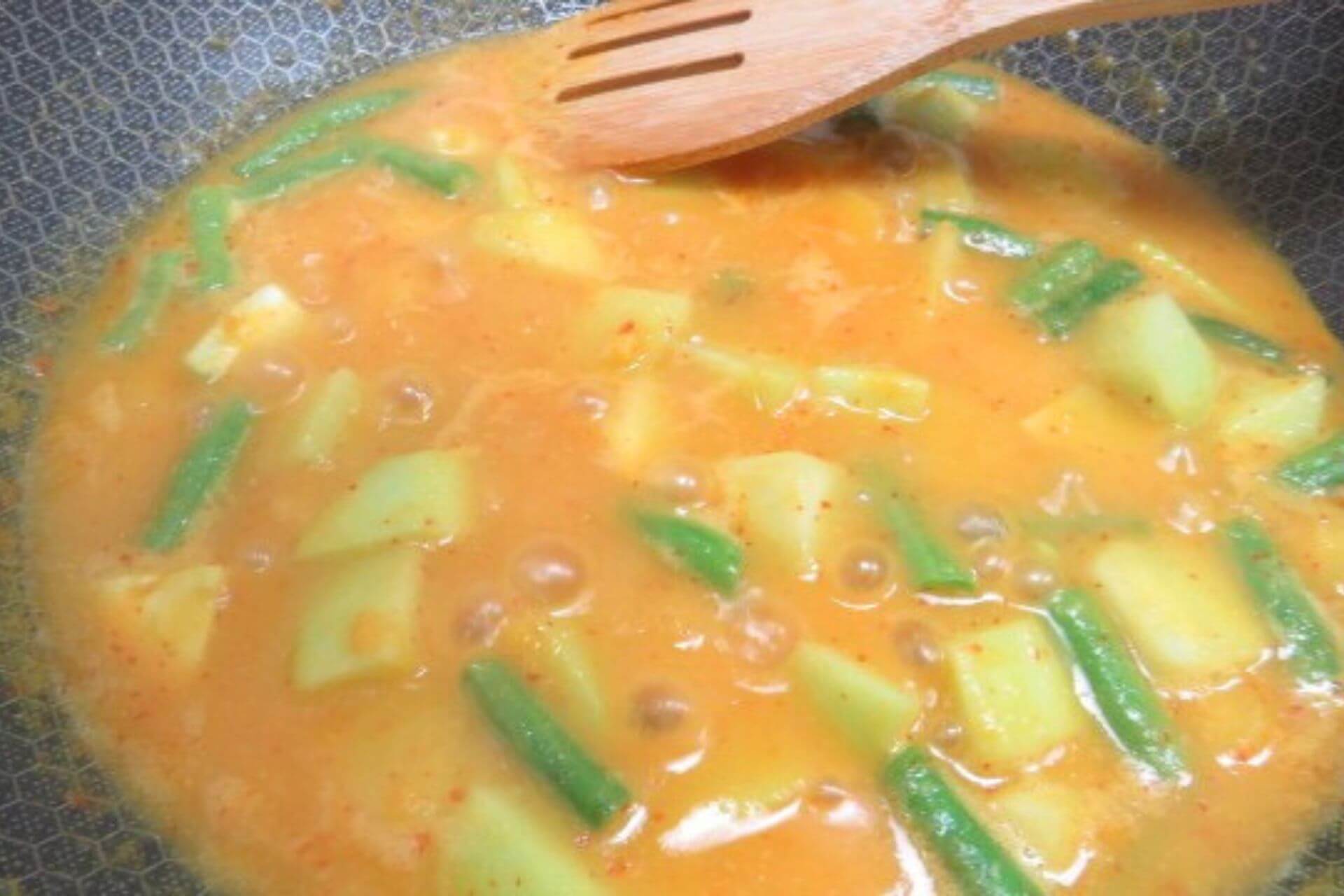
3. Add the eggplant, ground macadamia, coriander powder and salt. Cook for 3 minutes.
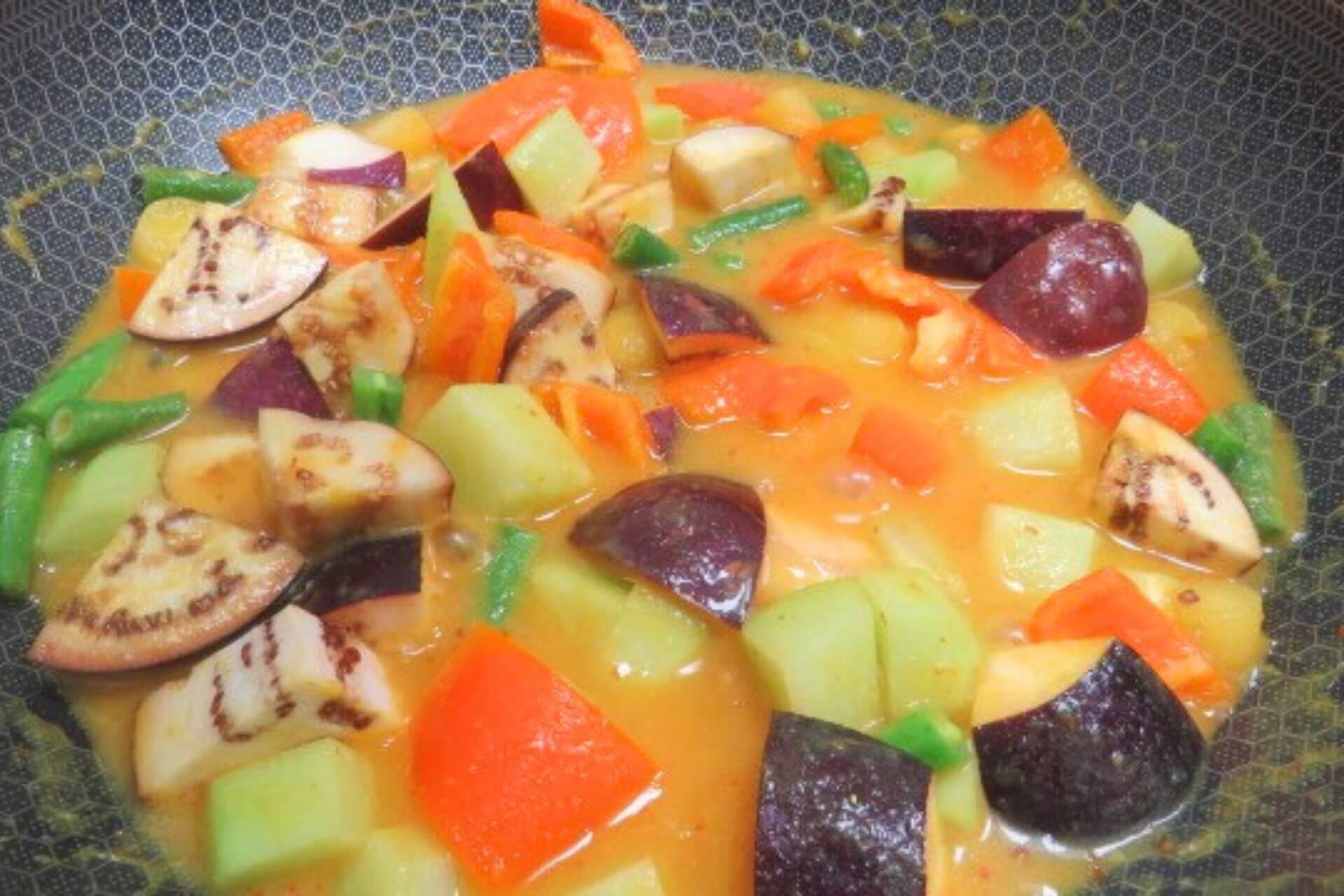
4. Add the coconut milk, tofu, and cabbage. Allow the gravy to boil and then turn off the heat.

5. Serve hot in a bowl with some steamed rice. Garnish with scallions.

Tips:
1. Dried shrimp paste gives the dish a unique savory flavor. Use a few frozen or fresh shrimp instead and stir-fry them with the spice paste.
2. Do not overcook or undercook the vegetables. They must be soft yet firm. Overcooking the veggies will make them mushy.
3. If using canned coconut milk, please add unsweetened coconut milk as it will otherwise make the dish too sweet.
4. Each veggie in this Sayur Lodeh recipe requires different cooking times, so do not cook all of them simultaneously. While chopping the veggies, be sure to cut them into even bite-sized pieces.
Serving suggestion:
Traditionally, the Sayur Lodeh is served with rice cakes (lotong) or steamed rice, or Nasi Kuning. I like to use jasmine rice to make compressed rice cakes.
Storage:
If you use fresh coconut milk, the dish will stay fresh for only a day or two in the refrigerator. You can freeze any leftover Sayur Lodeh in freezer-safe containers for 2-3 months. To reheat, thaw the gravy in the refrigerator, and heat it in a saucepot until thoroughly heated.
Other Indonesian recipes that you might like:
Sayur Lodeh
Equipment
- Wok (stovetop)
Ingredients
For the spice paste:
- 1 tsp fresh turmeric peeled, chopped
- 1 tbsp dried shrimp
- 3 dried chili deseeded
- 2 clove garlic optional
- 1 tbsp galangal
- 1 shallot medium
- 3 lemongrass white part
- 1-2 tbsp water filtered
For the Sayur Lodeh:
- 1 tbsp peanut oil
- 1 chayote cleaned, peeled, cubed
- 4 French green beans
- ½ cup carrot peeled, cubed
- ½ tsp coriander powder
- 1.5 tsp salt
- ¼ cup macadamia roasted, powdered
- 1 eggplant cubed
- 14 oz firm tofu
- ½ green cabbage small
- 3 cup coconut milk from one coconut
- 4 scallion for garnish
Instructions
How to make the Sayur Lodeh:
- Prepare the ingredients. Soak the ingredients for the spice paste for 10 minutes and grind to a smooth paste in a spice grinder.
- Heat a wok with the peanut oil and sauté the spice paste for a minute or until fragrant.
- Toss in the chayote, carrots, beans, and a cup of water and cook for 3 minutes on medium heat.
- Add the eggplant, ground macadamia, coriander powder, and salt. Cook for 3 minutes.
- Add the coconut milk, tofu, and cabbage. Allow the gravy to boil and then turn off the heat.
- Serve hot in a bowl with some steamed rice. Garnish with scallions.
Video
Notes
- Chayote must be cleaned (see blog post for instructions) or it will taste bitter in the curry.
Nutrition


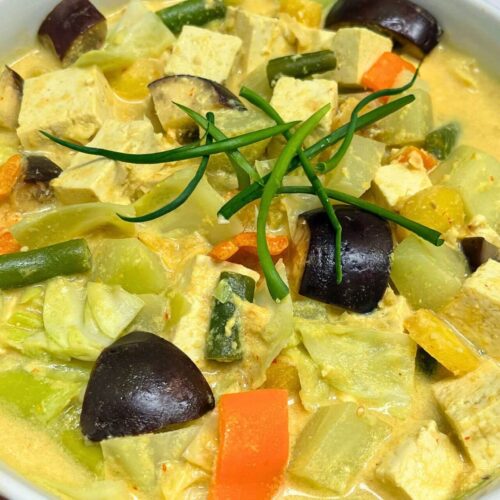
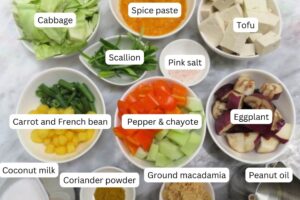
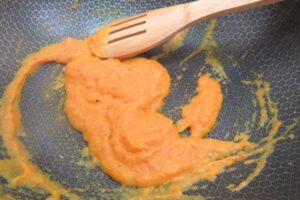
























Thanks for sharing such a nice thinking, post is pleasant, thats why i have read it
fully
this food is very delicious thank you for making this delicious recipe
Thanks for your positive feedback!